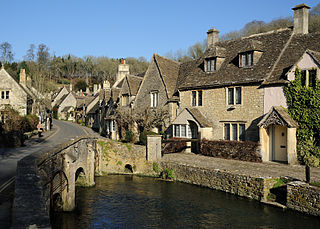
The Cotswolds is a region in central-southwest England, along a range of rolling hills that rise from the meadows of the upper Thames to an escarpment above the Severn Valley and Evesham Vale.

Oxfordshire is a ceremonial and non-metropolitan county in South East England. It is locally governed by Oxfordshire County Council and the lower-tier authorities of its five non-metropolitan districts: City of Oxford, Cherwell, South Oxfordshire, Vale of White Horse, and West Oxfordshire. The county is landlocked and bordered by Northamptonshire to the north-east, Warwickshire to the north-west, Buckinghamshire to the east, Berkshire to the south, Wiltshire to the south-west, and Gloucestershire to the west. The areas of Oxfordshire south of the River Thames were part of the historic county of Berkshire, including the county's highest point, the 261-metre (856 ft) White Horse Hill. The largest settlement in the county is Oxford, its only city, with an estimated population of 151,584.
Highgrove House is the family residence of King Charles III and Queen Camilla. It lies southwest of Tetbury in Gloucestershire, England. Built in the late 18th century, Highgrove and its estate were owned by various families until it was purchased in 1980 by the Duchy of Cornwall from Maurice Macmillan. Charles III remodelled the Georgian house with neo-classical additions in 1987. The duchy manages the estate and the nearby Duchy Home Farm.
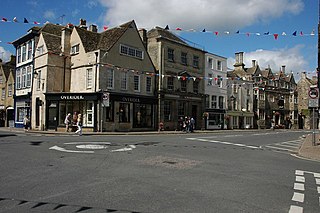
Tetbury is a town and civil parish inside the Cotswold district in Gloucestershire, England. It lies on the site of an ancient hill fort, on which an Anglo-Saxon monastery was founded, probably by Ine of Wessex, in 681. The population of the parish was 5,250 in the 2001 census, increasing to 5,472 at the 2011 census. The population was 6,453 in the 2021 Census.

Gatcombe Park is the country residence of Anne, Princess Royal, between the villages of Minchinhampton and Avening in Gloucestershire, England. Built in the late 18th century to the designs of George Basevi, it is a Grade II* listed building. It is a royal residence as it is home to the Princess Royal, and is privately owned. Parts of the grounds open for events, including horse trials and craft fairs.
Nether Lypiatt Manor is a compact, neo-Classical manor house in the mainly rural parish of Thrupp, near Stroud in Gloucestershire. It was formerly the country home of Prince and Princess Michael of Kent and is a Grade I listed building.

Llancaiach Fawr Manor is a Tudor manor house near the village of Nelson, located just to the north of the site of the former Llancaiach Colliery in the heart of the Rhymney Valley in South Wales. The semi-fortified house was built on the site of an earlier medieval structure, either on top of the previous dwelling or possibly incorporated within the eastern end of that building. It is a Grade I listed building and is now best known as the home of Colonel Edward Prichard, who hosted a visit by King Charles I of England in 1645.

Norman Jewson was an English architect-craftsman of the Arts and Crafts movement, who practised in the Cotswolds. He was a distinguished, younger member of the group which had settled in Sapperton, Gloucestershire, a village in rural southwest England, under the influence of Ernest Gimson. Surviving into old age, he brought their ideas and working methods into the second half of the twentieth century. His book of reminiscences has become established as a minor classic of the English Arts and Crafts movement. His repair of the Tudor Owlpen Manor in 1925–26 is often regarded as his most representative and successful work.
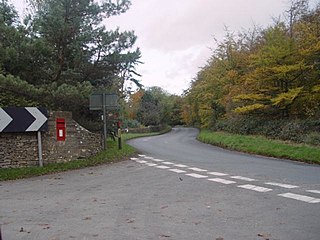
Tetbury Upton is a small village and civil parish in the Cotswolds area of Gloucestershire, England. The parish extends in an arc around the north, west and south of the town of Tetbury, and includes the village of Tetbury Upton on the B4014 road 1.5 miles (2 km) north of the town and the village of Doughton on the A433 road 1.2 miles (1.9 km) southwest of the town. Upton and Doughton were historically tythings in the ancient parish of Tetbury, and the area became a separate civil parish in 1894. By 1901 Tetbury Upton's total population reached 905, but by 2011 the population had declined to 309.

Stanway House is a Jacobean manor house, located near the village of Stanway in Gloucestershire, England. The manor of Stanway was owned by Tewkesbury Abbey for 800 years then for 500 years by the Tracy family and their descendants, the Earls of Wemyss and March.

Kingscote is a village and civil parish in the Cotswold district of Gloucestershire, England, set on the uplands near the south western edge of the Cotswold hills. It is situated about two miles (3 km) east of Uley, five miles (8 km) east of Dursley and four miles (6 km) west of Tetbury. The landscape is designated an Area of Outstanding Natural Beauty. The hamlet of Newington Bagpath lies to the west of the village; the parish lands extend near to the small village of Owlpen.

The A433 road is an A road and primary route in Gloucestershire, England.

Asthall Manor is a gabled Jacobean Cotswold manor house in Asthall, Oxfordshire. It was built in about 1620 and altered and enlarged in about 1916. The house is Grade II listed on the National Heritage List for England.

Whatley Manor is a hotel, restaurant and spa housed in a former farm and estate buildings, near Easton Grey in the southern Cotswolds, about 2 miles (3.2 km) west of Malmesbury, Wiltshire, England. The main building is a Grade II-listed house.
Hazleton Abbey was an abbey at Hazleton in Gloucestershire, England.

Tetbury railway station was the terminus station on the Tetbury branch line, serving the Gloucestershire town of Tetbury.
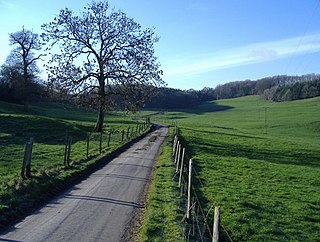
Kingscote Park is a Grade II listed house and country estate in Kingscote, near Tetbury, Gloucestershire, England. The original Kingscote Park was demolished in 1951. Both houses formed part of the manor of Kingscote which was held by the Kingscote family from the 12th century and is mentioned in the Domesday Book as 'Chingescote'.
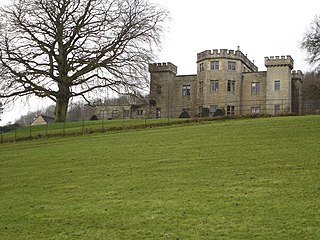
Lasborough Park is a Grade II listed country house in Newington Bagpath/Lasborough, Tetbury, Gloucestershire, England. The estate includes a medieval manor, a house, and parkland. The original medieval manor, Lasborough Farm, dates to the 11th century, and included terraced gardens. A manor house is record in the 14th century. The manor was surrounded by woodland and a deer park. Lasborough House and its pleasure grounds was built in 1794.

Painswick House is a grade I listed house in Painswick, Gloucestershire, England. It is surrounded by a Grade II* listed rococo garden.

Tetbury Market House, also known as Tetbury Town Hall, is a municipal building in the Market Place, Tetbury, Gloucestershire, England. The building, which was used both as a market house and as a town hall until the late 19th century, is a Grade I listed building.

















